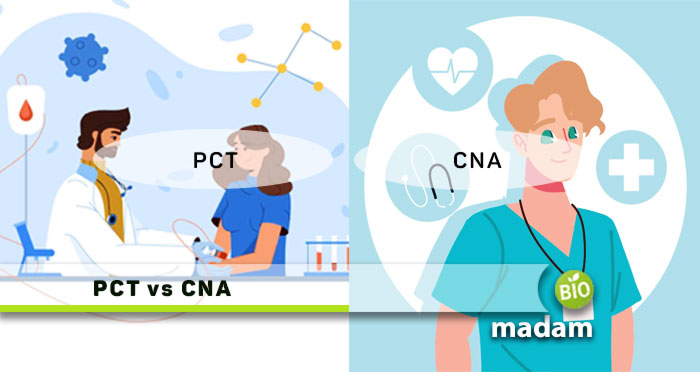Recently updated on October 5th, 2023 at 05:46 am
Choosing a career in healthcare or science can be challenging if you have not decided so far. Some of the common options include applied chemistry, pathology, nursing, horticulture, botany, etc. You may choose from these or opt for a technician or nurse as a profession.
Nurses and patient care technicians are an important part of the healthcare system that, most of the time, give their extra time to the unit. However, it shouldn’t be made a practice. Many people believe that both have the same responsibilities. However, it is not so.
A patient care technician and certified nursing assistant facilitate the physicians to take care of the patients. They make sure that the patient receives their medication and care adequately on time. It also includes moving or bathing a patient per need. Patient Care Technicians may also administer medication or take blood samples to detect RBC count, WBCs count, platelets, etc.
Here are all the differences between PCT and CNA to help you choose a suitable one.
Comparison Table
| Characteristic | CNA | PCT |
| Full form | Certified Nursing Assistant | Patient Care Technician |
| Job Description | Improving patient’s life quality | Improving patient’s life quality, taking samples, catheters, etc. |
| Training Content | Physiology, anatomy, nursing, nutrition, etc. | Lab work, nursing, nutrition, medical terminology, etc. |
| Education | High school diploma/GED, CNA training program | High school diploma/ GED, PCT training program |
| Certification | CNA certification | PCT certification |
| Job Environment | Nursing facilities, hospitals, retirement communities | Hospitals, cardiac centers, kidney centers, etc. |
| Salary | $32,000 | $46,000 |
What Is PCT?
A Patient Care Technician (PCT) works with patients who require assistance and supervision regularly. They help move the patients to other departments besides their day-to-day functions. Some states also authorize patient care technicians to dispense medication, draw blood or carry out other complex operational tasks.
Responsibilities of PCT
Patient care technicians (PCTs) help patients move, turn, exercise, and bathe. They also take care of the food preferences and dietary requirements in the absence of a certified nurse assistant. They may also carry out other medical procedures if authorized, including

- Dispensing medicines
- Drawing blood
- Taking samples for tests
- Wound care
- Operating dialysis equipment
What is CNA?
Certified Nurse Assistants (CNAs) are specialized nursing assistants who help patients with daily tasks. They assist them to move and ensure their comfort. CNAs are responsible for ensuring the emotional and physical comfort of the patient. As opposed to patient care technicians, certified nurse assistants do not perform a broad range of tasks. Certified Nursing Assistants act as patient caregivers.
Responsibilities of CNA
CNAs are majorly responsible for improving patients’ quality of life by helping them with daily tasks. Some of the responsibilities of a certified nurse assistant include:

- Feeding and bathing patients
- Checking the patient’s vitals, such as blood pressure through the specified stethoscope.
- Turning bedridden patients into their comfort
- Grooming patients
- Helping them with light exercise to improve their overall health
- Reviewing the patient’s food allergies and dietary restrictions
Differences Between PCT and CNA
Definition
CNA
Certified nurse assistants help patients with daily tasks like movement, food vigilance, medication dispensing, exercising, and bathing.
PCT
A patient care assistant may also draw blood, care for wounds or operate dialysis equipment, among other tasks performed by CNAs.
Job Description
CNA
CNAs contribute the majority to improving the patient’s quality of life. They help with daily tasks like bathing, dressing, exercising, and keeping the patient comfortable.
PCT
Alternatively, PCTs may perform all the tasks a certified nursing assistant performs. However, they are trained for more complex tasks like withdrawing blood, inserting catheters, and removing stitches.
Responsibilities
CNA
The primary responsibilities of a certified nursing assistant include assisting the patient in using the restroom, turning them, taking care of their dietary restrictions, helping patients with exercising, and measuring the patient’s vitals.
PCT
Patient care technicians may administer medication to the patient, draw blood and take samples, insert or remove catheters, remove stitches, and operate dialysis or ECG equipment.
Training Program
CNA
On the other hand, the training programs and modules to become a certified nurse assistant include nursing basics, anatomy, physiology, nutrition, infection, and disease control.
PCT
PCT programs also focus on the basics of the CNA program. Yet, they also include therapeutic exercises, patient diet, medical terminology, assistive devices, legal healthcare issues, physical examination, wheelchair management, laboratory work, and operating equipment for dialysis and ECG.
Education
CNA
You require a high school diploma or GED to pursue nursing assistant certification. Further, you need to take a CNA-specific program to pass the CNA certification exam.
PCT
Like CNA, you need a GED or high school diploma to opt for a PCT-specific training program. Pass the PCT certification examination to become a patient care technician.
Job Environment
CNA
Most CNAs work in government jobs, nursing facilities, hospitals, or retirement communities. Some CNAs also work part-time besides full-time, while others work for home services.
PCT
Similarly, patient care technicians work in the same facilities as CNAs, including nursing facilities, hospitals, and retirement communities. However, you may also find them working in specialized centers like cardiac care or kidney centers. PCTs and CNAs typically work full-time and may also have night shifts.
Salary
CNA
The US Bureau of Labor Statistics shows that the average annual salary for CNAs is around $32,000. It comes out to be around $15 per hour. Yet, experienced and skilled CNAs may earn better.
PCT
Contrarily, the average pay rate for patient care technicians is around $17 per hour, approximately$46,000 per annum. Patient care technicians with more than five years of experience may earn $50,000+ every year.
The Bottom Line
Certified nursing assistants and patient care technicians are integral to the healthcare system. They facilitate physicians by taking care of the patient’s dietary needs, daily supplements, movement, bathing, exercise, medication, etc. Patient care technicians may insert or remove catheters and stitches. They also operate ECG and dialysis equipment. Certified nursing assistants and patient care technicians typically do full-time jobs with night shifts. The annual income is also similar.
FAQs
Is PCT the same as CNA?
Many times PCTs are thought to be the same as CNAs. However, the scope of work of a patient care technician is beyond a certified nurse assistant. They may also perform dialysis, phlebotomy, ECG, or EKG.
Is a PCT the same as a medical assistant?
Patient care technicians and medical assistants perform similar functions. Yet, medical assistants are often employed in physician offices. On the other hand, patient care technicians work in retirement homes, hospitals, and specialized cardiac or kidney centers.
Is PCT easier than CNA?
PCTs and CNAs have similar roles and responsibilities in hospital and retirement facilities. However, PCTs require more training to perform laboratory tests, care for infections, insert or remove catheters and operate EKG or dialysis equipment.
Is CNA or PCT the better career for you?
Many people wonder if CNA or PCT is the right career choice. Certified nursing assistants are typically responsible for the emotional and physical well-being of the patient. Alternatively, patient care technicians assist the physicians further in diagnosis by withdrawing blood, taking samples, performing technical procedures, etc.
Sabrina is a licensed pharmacist with extensive knowledge of physiology and pharmacology. She gained distinction in pharmacology and quality management. Her research on the need for Hormone Replacement Therapy (HRT) and improving compliance for diabetic patients through effervescent granules gained wide recognition. She loves to work on innovations and research to learn something new regarding medicine every day. She has been writing for many years now and aims to improve the quality of life by imparting adequate information to the readers.

